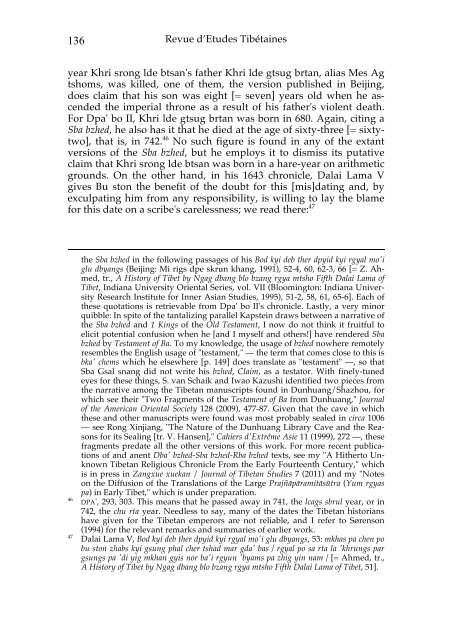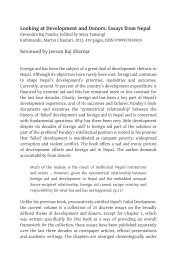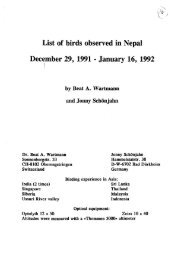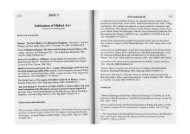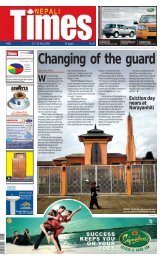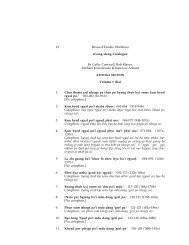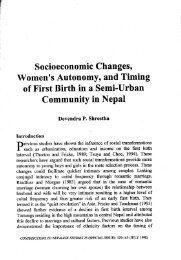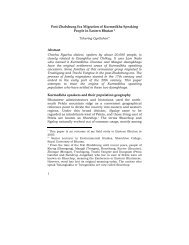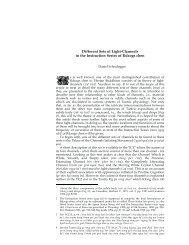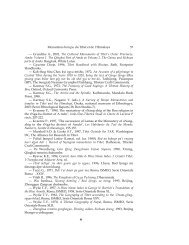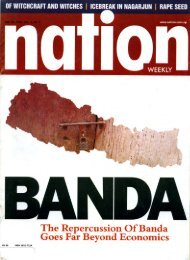Some Remarks on the Textual Transmission and Text of Bu ston
Some Remarks on the Textual Transmission and Text of Bu ston
Some Remarks on the Textual Transmission and Text of Bu ston
Create successful ePaper yourself
Turn your PDF publications into a flip-book with our unique Google optimized e-Paper software.
136<br />
Revue d’Etudes Tibétaines<br />
year Khri sr<strong>on</strong>g lde btsan's fa<strong>the</strong>r Khri lde gtsug brtan, alias Mes Ag<br />
tshoms, was killed, <strong>on</strong>e <strong>of</strong> <strong>the</strong>m, <strong>the</strong> versi<strong>on</strong> published in Beijing,<br />
does claim that his s<strong>on</strong> was eight [= seven] years old when he ascended<br />
<strong>the</strong> imperial thr<strong>on</strong>e as a result <strong>of</strong> his fa<strong>the</strong>r's violent death.<br />
For Dpa' bo II, Khri lde gtsug brtan was born in 680. Again, citing a<br />
Sba bzhed, he also has it that he died at <strong>the</strong> age <strong>of</strong> sixty-three [= sixtytwo],<br />
that is, in 742. 46 No such figure is found in any <strong>of</strong> <strong>the</strong> extant<br />
versi<strong>on</strong>s <strong>of</strong> <strong>the</strong> Sba bzhed, but he employs it to dismiss its putative<br />
claim that Khri sr<strong>on</strong>g lde btsan was born in a hare-year <strong>on</strong> arithmetic<br />
grounds. On <strong>the</strong> o<strong>the</strong>r h<strong>and</strong>, in his 1643 chr<strong>on</strong>icle, Dalai Lama V<br />
gives <strong>Bu</strong> st<strong>on</strong> <strong>the</strong> benefit <strong>of</strong> <strong>the</strong> doubt for this [mis]dating <strong>and</strong>, by<br />
exculpating him from any resp<strong>on</strong>sibility, is willing to lay <strong>the</strong> blame<br />
for this date <strong>on</strong> a scribe's carelessness; we read <strong>the</strong>re: 47<br />
46<br />
47<br />
<strong>the</strong> Sba bzhed in <strong>the</strong> following passages <strong>of</strong> his Bod kyi deb <strong>the</strong>r dpyid kyi rgyal mo'i<br />
glu dbyangs (Beijing: Mi rigs dpe skrun khang, 1991), 52-4, 60, 62-3, 66 [= Z. Ahmed,<br />
tr., A History <strong>of</strong> Tibet by Ngag dbang blo bzang rgya mtsho Fifth Dalai Lama <strong>of</strong><br />
Tibet, Indiana University Oriental Series, vol. VII (Bloomingt<strong>on</strong>: Indiana University<br />
Research Institute for Inner Asian Studies, 1995), 51-2, 58, 61, 65-6]. Each <strong>of</strong><br />
<strong>the</strong>se quotati<strong>on</strong>s is retrievable from Dpa' bo II's chr<strong>on</strong>icle. Lastly, a very minor<br />
quibble: In spite <strong>of</strong> <strong>the</strong> tantalizing parallel Kapstein draws between a narrative <strong>of</strong><br />
<strong>the</strong> Sba bzhed <strong>and</strong> 1 Kings <strong>of</strong> <strong>the</strong> Old Testament, I now do not think it fruitful to<br />
elicit potential c<strong>on</strong>fusi<strong>on</strong> when he [<strong>and</strong> I myself <strong>and</strong> o<strong>the</strong>rs!] have rendered Sba<br />
bzhed by Testament <strong>of</strong> Ba. To my knowledge, <strong>the</strong> usage <strong>of</strong> bzhed nowhere remotely<br />
resembles <strong>the</strong> English usage <strong>of</strong> "testament," — <strong>the</strong> term that comes close to this is<br />
bka' chems which he elsewhere [p. 149] does translate as "testament" —, so that<br />
Sba Gsal snang did not write his bzhed, Claim, as a testator. With finely-tuned<br />
eyes for <strong>the</strong>se things, S. van Schaik <strong>and</strong> Iwao Kazushi identified two pieces from<br />
<strong>the</strong> narrative am<strong>on</strong>g <strong>the</strong> Tibetan manuscripts found in Dunhuang/Shazhou, for<br />
which see <strong>the</strong>ir "Two Fragments <strong>of</strong> <strong>the</strong> Testament <strong>of</strong> Ba from Dunhuang," Journal<br />
<strong>of</strong> <strong>the</strong> American Oriental Society 128 (2009), 477-87. Given that <strong>the</strong> cave in which<br />
<strong>the</strong>se <strong>and</strong> o<strong>the</strong>r manuscripts were found was most probably sealed in circa 1006<br />
— see R<strong>on</strong>g Xinjiang, "The Nature <strong>of</strong> <strong>the</strong> Dunhuang Library Cave <strong>and</strong> <strong>the</strong> Reas<strong>on</strong>s<br />
for its Sealing [tr. V. Hansen]," Cahiers d'Extrême Asie 11 (1999), 272 —, <strong>the</strong>se<br />
fragments predate all <strong>the</strong> o<strong>the</strong>r versi<strong>on</strong>s <strong>of</strong> this work. For more recent publicati<strong>on</strong>s<br />
<strong>of</strong> <strong>and</strong> anent Dba' bzhed-Sba bzhed-Rba bzhed texts, see my "A Hi<strong>the</strong>rto Unknown<br />
Tibetan Religious Chr<strong>on</strong>icle From <strong>the</strong> Early Fourteenth Century," which<br />
is in press in Zangxue xuekan / Journal <strong>of</strong> Tibetan Studies 7 (2011) <strong>and</strong> my "Notes<br />
<strong>on</strong> <strong>the</strong> Diffusi<strong>on</strong> <strong>of</strong> <strong>the</strong> Translati<strong>on</strong>s <strong>of</strong> <strong>the</strong> Large Prajñāpāramitāsūtra (Yum rgyas<br />
pa) in Early Tibet," which is under preparati<strong>on</strong>.<br />
DPA', 293, 303. This means that he passed away in 741, <strong>the</strong> lcags sbrul year, or in<br />
742, <strong>the</strong> chu rta year. Needless to say, many <strong>of</strong> <strong>the</strong> dates <strong>the</strong> Tibetan historians<br />
have given for <strong>the</strong> Tibetan emperors are not reliable, <strong>and</strong> I refer to Sørens<strong>on</strong><br />
(1994) for <strong>the</strong> relevant remarks <strong>and</strong> summaries <strong>of</strong> earlier work.<br />
Dalai Lama V, Bod kyi deb <strong>the</strong>r dpyid kyi rgyal mo'i glu dbyangs, 53: mkhas pa chen po<br />
bu st<strong>on</strong> zhabs kyi gsung phal cher tshad mar gda' bas / rgyal po sa rta la 'khrungs par<br />
gsungs pa 'di yig mkhan gyis nor ba'i rgyun 'byams pa zhig yin nam / [= Ahmed, tr.,<br />
A History <strong>of</strong> Tibet by Ngag dbang blo bzang rgya mtsho Fifth Dalai Lama <strong>of</strong> Tibet, 51].


